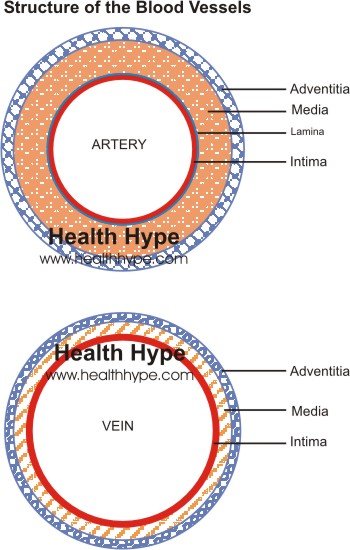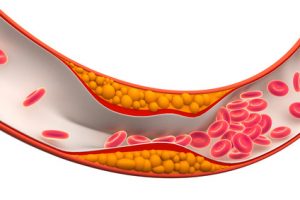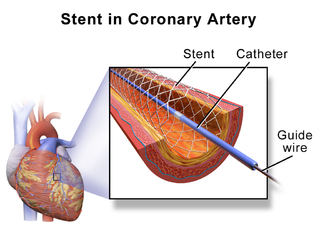Thickened Arteries and Veins – Causes of Blood Vessel Thickening
Blood vessels carry blood throughout the body. These vessels are tubes of varying sizes. Some are wider than others but the thickness of the blood vessel wall also differs. Blood vessels which carry large quantities of blood, especially blood under high pressure, have thicker walls. Since blood in the arteries are under higher pressure when leaving the heart, the arteries closest to the heart have the thickest walls. Veins tend to have much thinner walls.
Why do blood vessels thicken?
Thickening of a blood vessel may occur for a number of reasons. It is usually a result of changes within the vessel wall causing it to become thicker than normal. Alternatively it may arise from an enlargement of the vessel as a whole due to dilatation or birth defects. The tissue that makes up the wall may enlarge (hypertrophy) or abnormal masses may develop in the walls like fatty plaques in atherosclerosis.
Thickening of the wall may affect only one part of an artery or vein or result in thickening along the entire length of the vessel. Irregular thickening can lead to a host of complications as it may result in weakening of the wall over time, cause turbulent blood flow within the vessel or narrow the vessel lumen.
Read more on blood vessel structure.
Larger thickening only on one part of the blood vessel may also press on surrounding structures. However, thickening of the blood vessel is not always serious or entirely abnormal. Age related thickening of the wall of the blood vessel is a common occurrence. It may not always pose a serious threat. The elderly are also prone to further diseases which may exacerbate the wall thickening, such as atherosclerosis.
Causes of a Thickened Vessel
It is important to differentiate between the various causes of blood vessel wall thickening. Some of the conditions will narrow the lumen of the vessel wall. This restricts the blood flowing through the vessel. At other times the thickening weakens the vessel wall and there is a risk of a rupture (burst artery or vein). These complications can be serious and even life threatening at times.
Vasculitis
Vasculitis is the inflammation of the wall of a blood vessel. It may occur for a number of reasons, including infection, immune-mediated factors, toxic compounds, mechanical trauma, drugs and irradiation. There are various types of vasculitis and thickening of the vessel wall may be permanent due to fibrosis (tissue scarring) following persistent inflammation.
This is most evident in giant-cell (temporal) arteritis, Takayasu arteritis, polyarteritis nodosa, Kawasaki disease and Buerger disease (thromboangiitis obliterans). Phlebitis, which is the inflammation of a vein, is commonly seen in the deep leg veins that it is caused by a thrombus (thrombophlebitis). It may also arise with an infection.
Aneurysm
An aneurysm is the bulging of a portion of a blood vessel. It is an abnormal weakening and ballooning of the blood vessel wall. This can occur in an otherwise intact vessel wall (true aneurysm) or arise in a diseased blood vessel where the wall is already weakened (false aneurysm). It is not an actual thickening of the blood vessel wall but is rather a protrusion of the wall. An aortic aneurysm is one of the most common types.
Dissection
This tear in the blood vessel wall most commonly occurs in the largest artery, the aorta. An aortic dissection, also known as a dissecting aneurysm, occurs when blood enters a tear in the wall of the aorta. It forms a blood-filled channel within the wall that can rupture through the outer tunica adventitia layer. If left untreated, it may lead to death.
Atherosclerosis and Arteriosclerosis
Atherosclerosis is the formation of plaques within the arterial wall which bulges into the lumen of the vessel. It tends to affect large to medium sized arteries. Apart from the plaques, inflammation of the vessel wall and smooth muscle proliferation as part of atherogenesis may also cause swelling of the affected artery.
Arteriosclerosis affects smaller arteries and arterioles. Two types of arteriosclerosis known as hyaline and hyperplastic arteriosclerosis causes thickening of the vessel wall and results in narrowing of the artery. Another type of arteriosclerosis known as Monckeberg medial sclerosis does not cause arterial narrowing (stenosis) but calcified deposits build up in the wall.
Congenital
Certain conditions, like fibromuscular dysplasia, results in an irregular thickening of the arterial wall. As a result it causes abnormal narrowing of the affected artery. This condition is present from birth and may be due to developmental abnormalities since fetal life.
Vasoconstriction
Blood vessels, particularly arteries, can widen and narrow due to the action of the tiny muscles within its walls. Vasoconstriction is the narrowing of the blood vessel Persistent vasoconstriction as seen in primary hypertension may cause thickening of the affected vessel wall. Raynaud phenomenon is the excessive vasoconstriction of the small arteries and arterioles of the hands and feet. In the late stages of the disease, thickening of the intimal layer of the vessel wall may be noted.
Tumors
Tumors are abnormal tissue growths. It can be benign (non-cancerous) or malignant (cancerous). A tumor may cause irregular thickening of the vessel wall only at the location of the tumor. A hemangioma is one type of non-cancerous (benign) tumor of the blood vessel wall. An angiosarcoma is a rare type of cancerous (malignant) tumor of the blood vessel wall.
Surgery
Certain invasive procedures may cause thickening of the blood vessel wall, particularly where the procedure specifically involves the artery or vein. This is seen in angioplasty and stent insertion. Angioplasty is the procedure to widen the blood vessel. It is a common procedure for widening any narrowed coronary arteries of the heart. A stent is a metal wire mesh that is inserted to keep the blood vessel wide.
Proliferative restenosis is a complication of angioplasty and the use of bare metal stents. These procedures may result in thickening of the inner (intimal) layer of the vessel. New generation stents have coatings to prevent proliferation and thickening. In vascular replacement surgery, intimal thickening and atheromatous plaques may be seen in the grafts.








